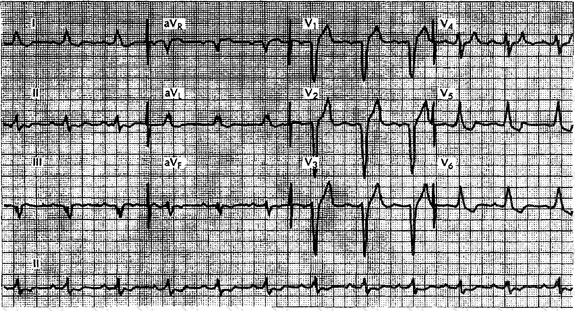If a 70-kg man runs on a treadmill at 8 mph and a 0% grade for 45 minutes, what is his caloric expenditure?
Which of the following conditions can prolong the QT interval?
A 110-pound female pedals a Monark cycle ergometer at 50 rpm against a resistance of 2.5 kiloponds. Calculate her absolute Yo2.
The P wave on the ECG can be
Informed consent is best described as
Subendocardial ischemia usually produces
Outcome assessment evaluates a program's effectiveness. Which of the following
statements about outcome assessment is NOT true?
A client is walking on a treadmill at 3.4 mph and a 5% grade. What is her Y02 in relative terms?
In the ECG strip shown below, what disorder is indicated?
Right-axis deviation may be caused by
A 143-pound woman regularly exercises on a treadmill at a speed of 5.5 mph and a 2% elevation. How much weight will she lose weekly if she exercises for a duration of 45 minutes per session, with a frequency of three sessions per week?
Do fitness instructors need management skills?
In the ECG shown on the following page, which of the following conduction abnormalities is indicated?

In response to various stimuli, movements of ions occur, causing the rapid loss of the internal negative potential. This process is known as
What resistance would you set a cycle ergometer at if your 80-kg client needs to train at 6 METs? Assume a 50 rpm cycling cadence.
According to the AACVPR, elements of successful adult education include all of the
following EXCEPT
In the ECG strip shown below, which arrhythmia is indicated?

Examine the six extremity leads shown in the figure below. What is the appropriate mean QRS axis?
At what running speed would you set a level treadmill at to elicit an Vo2 of 40 mL .
kg-1 . min-1?
A 55-kilogram woman trains on a cycle ergometer by pedaling at 60 rpm against a resistance of 1.5 kiloponds. What is her absolute Yo2?
A fitness newsletter, fitness library, and bulletin boards
Why would a fitness instructor have an interest in tort laws?
Staff certification is
Tall, positive T waves may be caused to all of the following EXCEPT
Which of the following statements regarding exercise for the elderly is FALSE?
Which energy source represents the largest potential energy store in the body?
Initial training sessions for a person with severe chronic obstructive pulmonary disease most likely would NOT include
When counseling a patient with metabolic syndrome, your emphasis should be on addressing underlying causes of the syndrome, such as
Transitional care exercise and rehabilitation programs are NOT appropriate for
Which of the following diseases is NOT typically associated with obesity?
Symptoms of claudication include
A specific benefit of regular exercise for patients with angina is
A common measure to assist in the evaluation of body fat distribution is
Which of the following situations indicates progression to independent and unsupervised exercise for a client after CABG surgery in an outpatient program?
A client with type 1 diabetes mellitus checks her fasting morning glucose level on her whole-blood glucose meter (fingerstick method), and the result of 253 mgldL (14 mmol/L). A urine test is positive for ketones before her exercise session. What action should you take?
The appropriate exercise HR for an individual on -blocking medication would generally
be
Osteoporosis is more prevalent in
All of the following are special considerations inprescribing exercise for the client with arthritis EXCEPT
Which of the following is not a feature of the metabolic syndrome?
Normal values for fasting blood sugar are
A 62-year-old, obese factory worker complains of pain in his right shoulder on arm abduction; on evaluation, decreased ROM and strength are noted. You also notice that he is beginning to use accessory muscles to substitute movements and to compensate. These symptoms may indicate
Women are likely to be deficient in both calcium and iron, because
Treatment for claudication during exercise includes all of the following EXCEPT
A target HR equivalent to 85% of HRR for a 25year-old male with a resting HR of 75
bpm would be equal to
An ideal weight-loss program should set a goal of _ pounds per week, with an energy intake of not less than _ kcal/day.
Which fat-soluble vitamin is important for bone formation?
In a budget for a clinical exercise rehabilitation program, all of the following are examples of variable expenses EXCEPT
An appropriate exercise for improving the strength of the low back muscles are